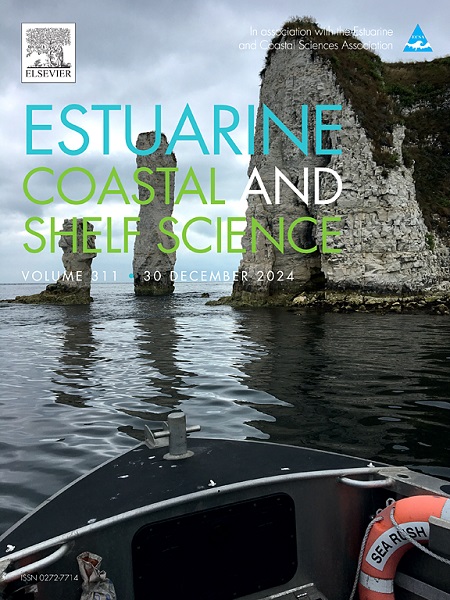Switch from source to Sink: Greenhouse gas fluxes in razor clam aquaculture ponds at different statuses of mangrove restoration
IF 2.6
3区 地球科学
Q1 MARINE & FRESHWATER BIOLOGY
引用次数: 0
Abstract
Aquaculture ponds significantly contribute to greenhouse gas (GHG) emissions. Ecological restoration of these ponds in China's coastal regions involves transitioning through stages of active cultivation, abandonment, and recovery to restore them into vibrant mangrove forests. However, the GHG emissions across different restoration stages remain under-researched. To bridge this gap, this study monitored carbon dioxide (CO2) and methane (CH4) emissions at the water-air interface over a year in Zhangjiang Mangroves, focusing on razor clam aquaculture ponds in three distinct stages of restoration.
Our study revealed that ponds were significant CH4 emitters, with abandoned ponds emitting the least (0.0049 tCH4 ha−1 yr−1), followed by restored ponds (0.0061 tCH4 ha−2 yr−1), while active culturing ponds had the highest emissions (0.0078 tCH4 ha−2 yr−1). Both active culturing and abandoned ponds were net carbon sources, emitting 4.81 tCO2 ha−2 yr−1 and 1.04 tCO2 ha−2 yr−1 respectively, while restored ponds served as a carbon sink, with a net uptake 0.43 tCO2 ha−2 yr−1 throughout the year. Temperature emerges as the most influential factors for both CO2, and CH4 emissions. Furthermore, the carbon sequestration capacity of mangrove forests offset 282.7 % of the total CO2-equivalent GHG flux from the restored ponds. As restoration progresses, the cessation of aquaculture and vegetation recovery can effectively mitigate the greenhouse effect from pond cultivation by 73.8 %. This study provides vital data for China's coastal aquaculture carbon emission inventory and insights into GHG changes following the conversion of aquaculture ponds to mangrove forests, highlighting the significance of mangrove restoration in reducing emissions.
从源到汇的转换:红树林恢复不同状态下蛏子养殖池塘的温室气体通量
水产养殖场对温室气体(GHG)排放有很大贡献。在中国沿海地区,这些池塘的生态恢复经历了积极开垦、废弃和恢复的过渡阶段,最终恢复为充满活力的红树林。然而,不同恢复阶段的温室气体排放研究仍然不足。为了弥补这一差距,本研究在张江红树林的水-空气界面监测了一年多的二氧化碳(CO2)和甲烷(CH4)排放,重点关注了三个不同恢复阶段的蛏子养殖池塘。研究发现,池塘是显著的CH4排放源,其中废弃池塘排放最少(0.0049 tCH4 ha−1 yr−1),其次是恢复池塘(0.0061 tCH4 ha−2 yr−1),而活跃养殖池塘排放最高(0.0078 tCH4 ha−2 yr−1)。活跃的养殖池和废弃的池塘都是净碳源,分别排放4.81 tCO2 ha−2 yr−1和1.04 tCO2 ha−2 yr−1,而恢复的池塘则是碳汇,全年净吸收0.43 tCO2 ha−2 yr−1。温度是影响CO2和CH4排放的最主要因素。此外,红树林的固碳能力抵消了恢复池塘总co2当量温室气体通量的282.7%。随着恢复的进行,停止养殖和植被恢复可以有效缓解池塘养殖造成的温室效应,减少幅度为73.8%。本研究为中国沿海水产养殖碳排放清查提供了重要数据,揭示了水产养殖池塘改红树林后的温室气体变化,凸显了红树林恢复对减排的重要意义。
本文章由计算机程序翻译,如有差异,请以英文原文为准。
求助全文
约1分钟内获得全文
求助全文
来源期刊
CiteScore
5.60
自引率
7.10%
发文量
374
审稿时长
9 months
期刊介绍:
Estuarine, Coastal and Shelf Science is an international multidisciplinary journal devoted to the analysis of saline water phenomena ranging from the outer edge of the continental shelf to the upper limits of the tidal zone. The journal provides a unique forum, unifying the multidisciplinary approaches to the study of the oceanography of estuaries, coastal zones, and continental shelf seas. It features original research papers, review papers and short communications treating such disciplines as zoology, botany, geology, sedimentology, physical oceanography.

 求助内容:
求助内容: 应助结果提醒方式:
应助结果提醒方式:


